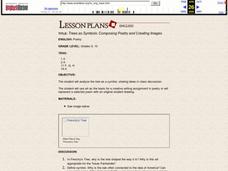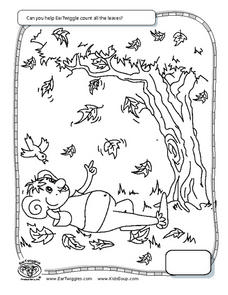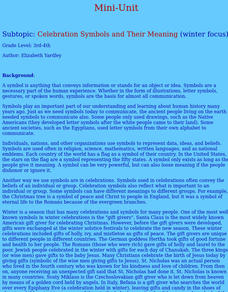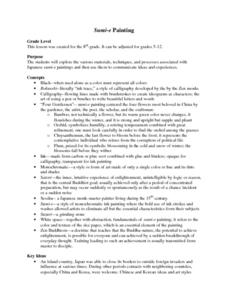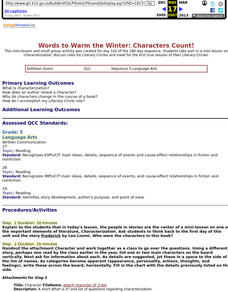Curated OER
Wonderful Wintertime
Students explore the seasons and how to describe them with adjectives. In this lesson about winter and descriptive language, students develop an understanding of the seasons specifically winter, and become equipped to describe them with...
Curated OER
People, Places, and Things
Students review art history in the Memphis Brooks Museum of Art. In this art history lesson, students discuss art vocabulary emphasizing landscape, portrait, and still life. They visit the museum and create their own pictures.
Curated OER
Symbolism: Finding the Hidden Meaning In Chinese Art
Pupils study and interpret Chinese art to find its symbolism, or the "hidden meanings" in this middle level lesson well suited for the Language Arts or Art classroom. An enrichment activity is included that allows each student to write...
Curated OER
Sunset Silhouettes
Students create "SUNSET SILHOUETTES" using primary colors, black construction paper, and glue in this elementary-level Art lesson. The lesson extension included with this lesson involves creating a nativity scene and might be...
Curated OER
Wiggly Spiders
Learners create "wiggly spiders" using black paint, construction paper, yarn, and their hands in this fun, messy, art lesson plan for the early elementary classroom. An ideal lesson plan for the Halloween holiday or for a lesson...
Curated OER
Toilet Paper Tube Snowman
Learners create "toilet paper tube" snowmen using toilet paper rolls, paints, pipecleaners, construtcion paper, wiggly eyes, and markers in this winter-time activity. The lesson is intended for the early elementary classroom.
Curated OER
Hanging Scrolls
Pupils explore prospective content for art, then select and use appropriate
subjects, symbols, and ideas to make art meaningful in this lesson plan suited for upper-elementary and middle level classrooms.
Curated OER
Trees as Symbols: Composing Poetry and Creating Images
Students analyze the tree as a symbol, sharing ideas in class discussion. They use art as the basis for a creative writing assignment in poetry or represent a selected poem with an original student drawing.
Curated OER
Whimsical Wooden Santa
Students create wooden Santas using small blocks of wood, paint, holiday materials, doll hair, glue, and berry leaves in this Holiday art lesson for the elementary classroom. The lesson includes resource links and a finished example of...
Clark County School District
Owl Moon by Jane Yolen
A thorough lesson plan takes your first grade class through Jane Yolen's beautiful Owl Moon. It crafts the unit with clear objectives, high-level guiding questions, cloze activities and sentence frames, and extension activities at the...
Curated OER
One Room Schoolhouse
Students study pictures and artifacts of the one-room schoolhouse. For this compare and contrast lesson,students list similarities and differences in schools of today and one-room schoolhouses. Then students use this analysis to write a...
Curated OER
EarTwiggle
In this counting leaves worksheet, students assist EarTwiggle in counting all the leaves found within a piece of art and then place their answer in the box provided at the lower right hand corner.
Curated OER
Create a Family Crest
Students create their own family crest using prior knowledge and Japanese and Native American examples of symbolic art. Lesson extensions include the creation of a school crest or woodblock examples of crests.
Curated OER
Celebration Symbols and Their Meaning
Students develop a symbol that represents something they wish to celebrate or include in a celebration of their choosing.
Curated OER
A Picture is worth a Thousand Words, But a Word Can be worth a Thousand Pictures!
Learners examine the process of creating mental images, or visualization, as a tool to increase reading comprehension. They practice visualizing while the teacher reads a passage to them by drawing what they hear focusing on including...
Curated OER
Sumi-e Painting
Students create Sumi-e paintings and explore the various materials, techniques, and processes associated with those paintings in an effort to better understand Japanese art and culture.
Curated OER
Jeffrey and Sloth: Six Traits of Writing
Use drawings as inspiration. Have learners doodle for 10 minutes before beginning the instructional activity. Then, have them use their doodles to inspire a story. Several writing activities are included here to play with writing. One of...
Brigham Young University
Out of the Dust: Guided Imagery
A guided imagery exercise is a great way to get readers thinking about writing. As part of their study of Out of the Dust, Karen Hesse’s 1998 Newbery Medal winning verse novel, class members listen to a reading of one of the poems from...
Gwinnett County Public Schools
Analysis of the Tuck Everlasting and The Birchbark House Text Exemplars
Looking to introduce some text-based questions into your ELA lessons? Practice the kinds of skills the Common Core demands with the seven text-based questions and the essay prompt provided here. Designed to be a three-day lesson, day one...
Curated OER
From Light to Dark and Back
Experiment with light and dark in a series of interactive activities that lead up to reading and writing poetry. Class members have the opportunity to observe their feelings while sitting in the light and dark and to play with shadow...
Curated OER
Japan and Art
Learners discuss the art of Japan as it relates to Japanese culture and geography and then create individual postcards reflecting the information learned from the lesson. This lesson includes possible enrichments.
Curated OER
The Hat
Honing reading and communication skills through the theme of farm animals is the focus of this lesson. Students read a book about Scandinavian farm animals and complete prediction journal activities. They complete a worksheet about the...
Curated OER
Words to Warm the Winter: Characters Count!
Fifth graders take part in a mini-lesson on characterization, discuss roles for Literary Circles and meet for the first true session of their Literary Circles.
Curated OER
Summing up Winter!
Students review the concept of silent reading. Through modeling and guided practice, they follow four given steps in summarizing the beginning of a written passage. Then they continue to read the passage independently and follow the same...









